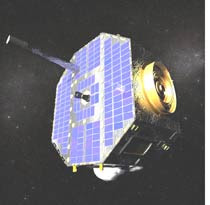IBEX probe sent to probe the heliosphere
 On Sunday, NASA successfully launched the Pegasus launch vehicle, which launched a small IBEX (Interstellar Boundary Explorer) probe into orbit the size of a bus tire worth $ 165 million.
On Sunday, NASA successfully launched the Pegasus launch vehicle, which launched a small IBEX (Interstellar Boundary Explorer) probe into orbit the size of a bus tire worth $ 165 million.Now the device on its own engine will fly away from the Earth by 320 thousand km, and after 45 days it will begin its two-year service there, studying the borders of the heliosphere - the area where the solar wind encounters cold interstellar gas. Unlike the famous Voyager instruments, the new probe itself will not fly to the heliosphere border, but will scan it (and other parts of the solar system) at a distance. For this, it has two sensors for measuring the mass and energy of the solar wind in all directions.
Solar wind - charged particles that fly from the Sun at a speed of up to 1200 km / s. They create around the solar system something like a protective shield (heliosphere), which prevents the flow of dangerous cosmic radiation. Scientists recently discovered that solar wind pressure is now at its lowest level in 50 years , although the exact cause of this phenomenon remains a mystery. Over the two years of operation, the IBEX unit will help confirm or refute the theory that the heliosphere is compressed in volume.
Read more: IBEX Facts ( PDF ).
')
Source: https://habr.com/ru/post/42840/
All Articles